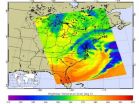(Press-News.org) Malaria, the leading cause of death among children in Africa, could be eliminated if three-fourths of the population used insecticide-treated bed nets, according to a new study from the National Institute for Mathematical and Biological Synthesis (NIMBioS).
The study, which uses a mathematical model, found that use of insecticide-treated bed nets or ITNs positively affected the infection's reproduction number, or R, which is the primary epidemiological number used to determine the degree which a disease can spread through a population. The model concludes that if 75 percent of the population were to use ITNs, malaria could be eliminated.
The treated mosquito net forms a protective barrier around people sleeping under them. The insecticide not only kills the mosquitoes, which carry the malaria parasite, and other insects, it also repels mosquitoes, reducing the number that enter the house and attempt to feed on people inside. With ITNs, the number of mosquitoes, as well as their length of life, is reduced, which is why the density of nets in a community is important.
Overcoming cultural resistance to using bed nets in communities where people view the nets as intrusive has been a major challenge of international malaria prevention agencies, however. There is evidence also that in some countries more bed nets go to the rich than the poor. Health groups are devising strategies to encourage use of the bed nets and to make sure they are distributed more equitably.
"Based on the results, it's clear that educational campaigns around the use of bed-nets must continue as the nets play a critical role in reducing the transmission of malaria," said Folashade Agusto, the study's lead author and participant in the NIMBioS Investigative Workshop on Malaria Modeling and Control, whose other participants co-authored the study. A former NIMBioS postdoctoral fellow, Agusto is an assistant professor of mathematics at Austin Peay State University.
Malaria has already been eradicated in Europe, North America, the Caribbean, and parts of Asia and South-Central America, and yet, the World Health Organization estimates that every year 250 million people become infected with malaria and nearly one million die.
INFORMATION:
Citation: Agusto FB, Del Valle SY, Blayneh KW, Ngonghala CN, Goncalves MJ, Li N, Zhao R, Gong H. 2013. The impact of bed-net use on malaria prevalence. Journal of Theoretical Biology, 320: 58-65. http://www.sciencedirect.com/science/article/pii/S0022519312006315
Contact Information: Catherine Crawley, NIMBioS, ccrawley@nimbios.org; 865-974-9350
Charles Booth, Austin Peay State University, boothcw@apsu.edu, 931-221-7597
The National Institute for Mathematical and Biological Synthesis (NIMBioS) brings together researchers from around the world to collaborate across disciplinary boundaries to investigate solutions to basic and applied problems in the life sciences. NIMBioS is sponsored by the National Science Foundation, the U.S. Department of Homeland Security, and the U.S. Department of Agriculture with additional support from The University of Tennessee, Knoxville.
END
VIDEO:
This animation of NOAA GOES-13 satellite imagery from March 5-7, 2013, shows the progression of a cold front from the west associated with a low pressure system that brought snow...
Click here for more information.
The merging of two low pressure areas into a large Nor'easter on March 6 brought winter weather advisories and warnings to the Mid-Atlantic. NASA's Aqua satellite captured an infrared and near infrared image of the storm's power, and NASA created an animation ...
The star Eta Carinae is ready to blow. 170 years ago, this 100-solar-mass object belched out several suns' worth of gas in an eruption that made it the second-brightest star after Sirius. That was just a precursor to the main event, since it will eventually go supernova.
Supernova explosions of massive stars are common in spiral galaxies like the Milky Way, where new stars are forming all the time. They are almost never seen in elliptical galaxies where star formation has nearly ceased. As a result, astronomers were surprised to find a young-looking supernova in an old ...
With data from 73 ice and sediment core monitoring sites around the world, scientists have reconstructed Earth's temperature history back to the end of the last Ice Age.
The analysis reveals that the planet today is warmer than it's been during 70 to 80 percent of the last 11,300 years.
Results of the study, by researchers at Oregon State University (OSU) and Harvard University, are published this week in a paper in the journal Science.
Lead paper author Shaun Marcott of OSU says that previous research on past global temperature change has largely focused on the ...
HOUSTON – (March 7, 2013) – Results of a study using several imaging methods showed that CCSVI (chronic cerebrospinal venous insufficiency) occurs at a low rate in both people with multiple sclerosis (MS) and non-MS volunteers, contrary to some previous studies. The research by an interdisciplinary team at The University of Texas Health Science Center at Houston (UTHealth) was published in a recent early online edition of the Annals of Neurology.
"Our results in this phase of the study suggest that findings in the major veins that drain the brain consistent with CCSVI ...
A new report from the Wildlife Conservation Society Canada (WCS Canada) creates a conservation strategy that will promote wildlife resiliency in the Southern Canadian Rockies to the future impacts of climate change and road use. The report's "safe passages and safe havens" were informed in part by an assessment of six iconic species—bull trout, westslope cutthroat trout, grizzly bears, wolverines, mountain goats and bighorn sheep—five of which were ranked as highly vulnerable to projected changes.
Nestled between Glacier National Park in Montana and Banff National ...
In the movie Alien, the title character is an extraterrestrial creature that can survive brutal heat and resist the effects of toxins.
In real life, organisms with similar traits exist, such as the "extremophile" red alga Galdieria sulphuraria.
In hot springs in Yellowstone National Park, Galdieria uses energy from the sun to produce sugars through photosynthesis.
In the darkness of old mineshafts in drainage as caustic as battery acid, it feeds on bacteria and survives high concentrations of arsenic and heavy metals.
How has a one-celled alga acquired such ...
Scientists at UC San Francisco have found a more precise way to turn off genes, a finding that will speed research discoveries and biotech advances and may eventually prove useful in reprogramming cells to regenerate organs and tissues.
The strategy borrows from the molecular toolbox of bacteria, using a protein employed by microbes to fight off viruses, according to the researchers, who describe the technique in the current issue of Cell.
Turning off genes is a major goal of treatments that target cancer and other diseases. In addition, the ability to turn genes off ...
To students in Jennifer Burg's computer science classes, making music is the main objective. But her goal is to get them to understand how the underlying technology works – and to love it so much they decide on a science-based career path.
And that, Burg's study has shown, has helped Wake Forest University fulfill the national imperative to increase the number of majors in the STEM disciplines of science, technology, engineering and math.
The results of Burg's research, "Computer Science 'Big Ideas' Play Well in Digital Sound and Music," will be published during the ...
Outdoor heat is associated with a significantly increased risk of emergency hospitalization for respiratory disorders in the elderly, according to a large epidemiological study of more than 12.5 million Medicare beneficiaries.
"While outdoor heat has been shown to increase respiratory mortality, evidence on the relationship between heat and respiratory hospitalizations has been less consistent," said lead author G. Brooke Anderson, PhD, postdoctoral fellow in the Department of Biostatistics at the Johns Hopkins Bloomberg School of Public Health. "In the largest population ...
A study by the University of Liverpool has found that celebrity endorsement of a food product encourages children to eat more of the endorsed product. It also found that children were prompted to eat more of the endorsed product when they saw the celebrity on TV in a different context.
Celebrity endorsement is an effective method of creating value, recognition and credibility for a brand, and celebrities are frequently used in television advertising to induce children to try foods. An example of this is former England international soccer player Gary Lineker, now principally ...




